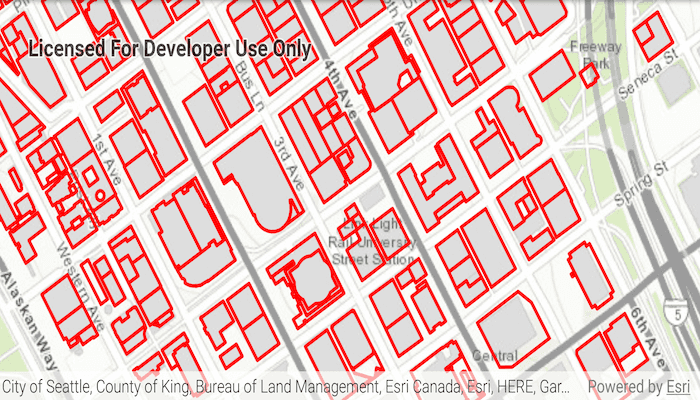Display a layer from a WFS service, requesting only features for the current extent.

Use case
WFS is an open standard with functionality similar to ArcGIS feature services. Runtime support for WFS allows you to interoperate with open systems, which are often used in inter-agency efforts, like those for disaster relief.
How to use the sample
Pan and zoom to see features within the current map extent.
How it works
- Create a
WfsFeatureTablewith a URL. - Create a
FeatureLayerfrom the feature table and add it to the map. - Add a
NavigationChangedListenerto the map view and listen for aNavigationChangedEvent. Check if itisNavigating()to detect when the user has stopped navigating the map. - When the user is finished navigating, use
populateFromServiceAsync(...)to load the table with data for the current visible extent.
Relevant API
- FeatureLayer
- WfsFeatureTable
- WfsFeatureTable.populateFromServiceAsync
About the data
This service shows building footprints for downtown Seattle. For additional information, see the underlying service on ArcGIS Online.
Tags
browse, catalog, feature, interaction cache, layers, OGC, service, web, WFS
Sample Code
/*
* Copyright 2019 Esri
*
* Licensed under the Apache License, Version 2.0 (the "License");
* you may not use this file except in compliance with the License.
* You may obtain a copy of the License at
*
* http://www.apache.org/licenses/LICENSE-2.0
*
* Unless required by applicable law or agreed to in writing, software
* distributed under the License is distributed on an "AS IS" BASIS,
* WITHOUT WARRANTIES OR CONDITIONS OF ANY KIND, either express or implied.
* See the License for the specific language governing permissions and
* limitations under the License.
*/
package com.esri.arcgisruntime.sample.displaywfslayer;
import android.graphics.Color;
import android.os.Bundle;
import androidx.appcompat.app.AppCompatActivity;
import com.esri.arcgisruntime.ArcGISRuntimeEnvironment;
import com.esri.arcgisruntime.data.QueryParameters;
import com.esri.arcgisruntime.data.ServiceFeatureTable;
import com.esri.arcgisruntime.geometry.Envelope;
import com.esri.arcgisruntime.geometry.Point;
import com.esri.arcgisruntime.layers.FeatureLayer;
import com.esri.arcgisruntime.mapping.ArcGISMap;
import com.esri.arcgisruntime.mapping.BasemapStyle;
import com.esri.arcgisruntime.mapping.Viewpoint;
import com.esri.arcgisruntime.mapping.view.MapView;
import com.esri.arcgisruntime.ogc.wfs.WfsFeatureTable;
import com.esri.arcgisruntime.symbology.SimpleLineSymbol;
import com.esri.arcgisruntime.symbology.SimpleRenderer;
public class MainActivity extends AppCompatActivity {
private MapView mMapView;
@Override
protected void onCreate(Bundle savedInstanceState) {
super.onCreate(savedInstanceState);
setContentView(R.layout.activity_main);
// authentication with an API key or named user is required to access basemaps and other
// location services
ArcGISRuntimeEnvironment.setApiKey(BuildConfig.API_KEY);
mMapView = findViewById(R.id.mapView);
// create a map with topographic basemap and set it to the map view
ArcGISMap map = new ArcGISMap(BasemapStyle.ARCGIS_TOPOGRAPHIC);
mMapView.setMap(map);
// create an initial extent to load
Point topLeft = new Point(-13618106.950944, 6042391.201455);
Point bottomRight = new Point(-13617513.444292, 6041961.243171);
Envelope initialExtent = new Envelope(topLeft, bottomRight);
mMapView.setViewpoint(new Viewpoint(initialExtent));
// create a FeatureTable from the WFS service URL and name of the layer
WfsFeatureTable wfsFeatureTable = new WfsFeatureTable(getString(R.string.wfs_service_url),
getString(R.string.seattle_downtown_table));
// set the feature request mode to manual in this mode, you must manually populate the table - panning and zooming
// won't request features automatically
wfsFeatureTable.setFeatureRequestMode(ServiceFeatureTable.FeatureRequestMode.MANUAL_CACHE);
// create a feature layer to visualize the WFS features
FeatureLayer wfsFeatureLayer = new FeatureLayer(wfsFeatureTable);
// apply a renderer to the feature layer
SimpleRenderer renderer = new SimpleRenderer(new SimpleLineSymbol(SimpleLineSymbol.Style.SOLID, Color.RED, 3));
wfsFeatureLayer.setRenderer(renderer);
// add the layer to the map's operational layers
map.getOperationalLayers().add(wfsFeatureLayer);
// make an initial call to load the initial extent's data from the WFS, using the WFS spatial reference
populateFromServer(wfsFeatureTable, initialExtent);
// use the navigation completed event to populate the table with the features needed for the current extent
mMapView.addNavigationChangedListener(navigationChangedEvent -> {
// once the map view has stopped navigating
if (!navigationChangedEvent.isNavigating()) {
populateFromServer(wfsFeatureTable, mMapView.getVisibleArea().getExtent());
}
});
}
/**
* Create query parameters using the given extent to populate the WFS table from service.
*
* @param wfsFeatureTable the WFS feature table to populate
* @param extent the extent used to define the QueryParameters' geometry
*/
private void populateFromServer(WfsFeatureTable wfsFeatureTable, Envelope extent) {
// create a query based on the current visible extent
QueryParameters visibleExtentQuery = new QueryParameters();
visibleExtentQuery.setGeometry(extent);
visibleExtentQuery.setSpatialRelationship(QueryParameters.SpatialRelationship.INTERSECTS);
// populate the WFS feature table based on the current extent
wfsFeatureTable.populateFromServiceAsync(visibleExtentQuery, false, null);
}
@Override
protected void onPause() {
mMapView.pause();
super.onPause();
}
@Override
protected void onResume() {
super.onResume();
mMapView.resume();
}
@Override protected void onDestroy() {
mMapView.dispose();
super.onDestroy();
}
}